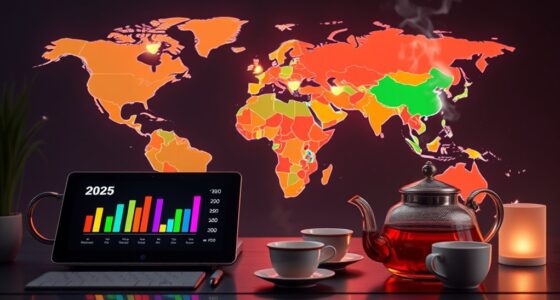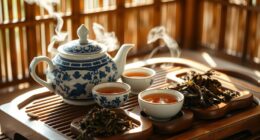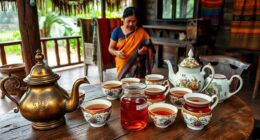You’ll find that micro-lot teas in Vietnam are gaining recognition for their focus on quality and sustainability. Farmers cultivate small batches with careful attention, using eco-friendly methods that preserve land and flavor. These teas reflect Vietnam’s rich cultural traditions and terroirs, offering nuanced flavors rooted in history. As this movement grows, it highlights Vietnam’s commitment to craftsmanship and environmental respect. Keep exploring to uncover how these tiny batches are shaping the future of Vietnamese tea.
Key Takeaways
- Micro-lot teas in Vietnam highlight sustainable farming and high craftsmanship, emphasizing quality over quantity.
- Small plantations enable meticulous harvesting and processing, preserving unique regional flavors.
- These teas reflect Vietnam’s cultural heritage and traditional cultivation techniques passed through generations.
- Growing consumer awareness and global demand boost Vietnam’s reputation in the premium tea market.
- The rise of micro-lot teas signifies Vietnam’s dedication to environmental stewardship and cultural preservation.

Have you ever wondered what makes Vietnamese teas stand out in the global market? It’s a combination of factors, but one of the most significant is the rise of micro-lot teas—small, carefully cultivated batches that emphasize quality over quantity. These teas are a reflection of Vietnam’s commitment to sustainable farming practices, which help preserve the land and ensure the health of the environment for future generations. When you taste a micro-lot tea, you’re experiencing more than just a beverage; you’re savoring a piece of the country’s cultural heritage. The tradition of tea cultivation here isn’t just about producing a drink; it’s about maintaining age-old techniques passed down through generations and respecting the land that provides the leaves.
Micro-lot Vietnamese teas showcase tradition, sustainability, and cultural heritage in every carefully crafted sip.
You might notice that micro-lot teas are often grown on small plantations where farmers prioritize quality and ecological balance. Unlike mass-produced teas, these small-scale farms allow for meticulous attention to detail, from picking the leaves at peak ripeness to processing them with care. Because these growers focus on sustainable farming, they avoid harmful chemicals and heavy reliance on machinery, which can damage the soil and water sources. Instead, they use natural fertilizers and organic methods, ensuring the land remains fertile and vibrant. This approach not only benefits the environment but also enhances the unique flavors and aromas found in each batch. When you drink micro-lot tea, you’re tasting the difference that sustainable practices bring—complex, nuanced, and deeply rooted in the land’s natural qualities. Additionally, the rise of small-scale farming highlights Vietnam’s dedication to eco-friendly practices and high-quality craftsmanship.
Furthermore, micro-lot teas embody Vietnam’s rich cultural heritage. Tea cultivation in Vietnam isn’t just an agricultural activity; it’s a cultural ritual intertwined with local traditions, festivals, and social gatherings. Many micro-lot tea farmers are guardians of this heritage, maintaining time-honored techniques while adapting to modern standards. The small batches often reflect specific regional characteristics, capturing the essence of local terroirs—be it the misty mountains of Northern Vietnam or the lush valleys of Central Vietnam. As you explore these teas, you gain a window into Vietnam’s history and cultural identity, expressed through the flavors and stories behind each harvest.
In essence, micro-lot teas are a tribute to Vietnam’s dedication to preserving its cultural roots while embracing sustainable farming practices. They highlight the country’s respect for tradition, land, and environment. When you sip such a tea, you’re not just enjoying a drink—you’re participating in a centuries-old cultural legacy that values quality, environmental stewardship, and cultural continuity. The quiet rise of micro-lot teas symbolizes Vietnam’s broader commitment to craftsmanship and sustainability, making each cup a meaningful experience rooted in history and care.
Frequently Asked Questions
How Are Micro-Lot Teas Different From Regular Vietnamese Teas?
Micro-lot teas differ from regular Vietnamese teas because they focus on single origin, small-scale harvests, highlighting unique flavor profiles. You’ll notice the artisanal craftsmanship involved, as each batch is carefully processed to preserve its distinct qualities. Unlike mass-produced teas, micro-lots offer a more personalized experience, allowing you to savor the nuanced flavors and aromas that come from limited, carefully selected tea leaves, making each cup special and authentic.
What Is the Best Way to Brew Micro-Lot Teas?
To brew micro-lot teas perfectly, focus on enhancing their tea aroma by using the right brewing temperature. Generally, steep green teas at about 75-80°C and black teas at 90-95°C. Use filtered water and steep for 2-3 minutes to avoid bitterness. Adjust the temperature slightly to bring out the best flavors, ensuring that each cup highlights the delicate nuances of your micro-lot tea.
How Do Micro-Lot Teas Impact Local Vietnamese Communities?
Micro-lot teas impact local Vietnamese communities by fostering economic development and supporting cultural preservation. When you buy these teas, you’re helping small-scale farmers earn fair income and invest in sustainable practices. This encourages the preservation of traditional tea-making techniques and local heritage. Your support promotes community growth, ensuring that cultural practices thrive alongside economic progress, creating a positive cycle that benefits everyone involved in micro-lot tea production.
Are Micro-Lot Teas More Expensive Than Traditional Teas?
You’ll find that micro-lot teas are typically more expensive than traditional teas, mainly due to their limited production and higher quality evaluation standards. When comparing prices, micro-lot teas often cost more because they’re carefully crafted in small batches, emphasizing unique flavors and craftsmanship. This price comparison reflects their premium status, but many tea enthusiasts value the superior quality and distinctive taste, making the extra cost worthwhile for connoisseurs.
What Regions in Vietnam Are Known for Micro-Lot Tea Production?
Did you know that regions like Lam Dong and Yen Bai are gaining fame for micro-lot tea production? These areas boast unique tea terroirs and meticulous cultivation techniques, creating exceptional flavors. You’ll find these micro-lots carefully tended, often in small batches, highlighting the distinctive qualities of each region. By focusing on specific terroirs, Vietnamese farmers craft teas that stand out for their purity and complexity, appealing to connoisseurs worldwide.
Conclusion
As you explore Vietnam’s micro-lot teas, think of each small harvest like a hidden gem — rare, precious, and full of character. Just like a master painter carefully chooses each brushstroke, farmers nurture these tiny plots to create extraordinary flavors. With over 50% of premium teas now coming from micro-lots, you’re witnessing a quiet revolution that transforms humble beginnings into world-class treasures. Keep an eye on this movement; it’s redefining what tea can truly be.










